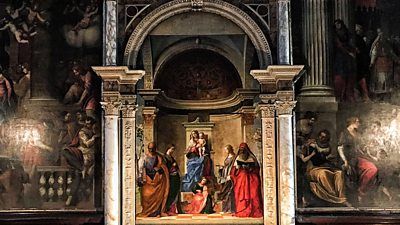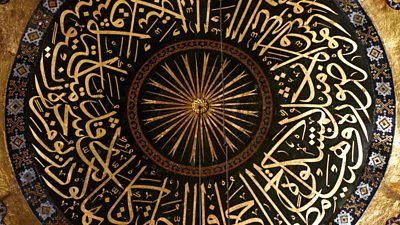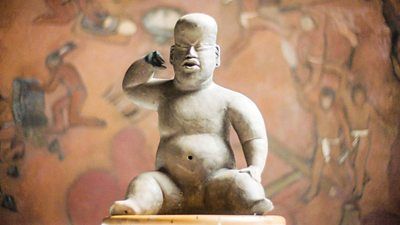The BEST episodes of Civilisations (2018)
Every episode of Civilisations (2018) ever, ranked from best to worst by thousands of votes from fans of the show. The best episodes of Civilisations (2018)!
Explore the visual culture of societies from around the globe, revealing alongside the magnificent objects made in the West the wealth of treasures created by other cultures, from the landscape scrolls of classical China and the sculpture of the Olmecs to African bronzes, Japanese prints and Mughal miniatures.

#1 - The Triumph of Art
Season 1 - Episode 5 - Aired 3/29/2018
Think Renaissance and you think Italy. But in the 15th and 16th centuries the great Islamic empires experienced their own extraordinary cultural flowering. The two phenomena did not unfold in separate artistic universes; they were acutely conscious of, and in competition with, each other and mutually open to influences flowing both ways. The fifth film in Civilisations goes east and west with Simon Schama: to Papal Rome but also to Ottoman Istanbul and Mughal Lahore and Agra, revealing those connections and rivalries, and examining how the role of artists from the different traditions of West and East developed in the years that followed the Renaissances. That rivalry unfolds most spectacularly over the creation of domes - in Ottoman Istanbul the great engineer-architect Mimar Sinan builds the light-flooded Süleymaniye mosque, while at the same time in Rome Michelangelo designs the great dome over the St Peter’s Basilica. The fate of the hero-artist, seemingly touched by God, with the gift of making visual miracles, diverged in east and west. In Europe, artists such as Benvenuto Cellini with his sculpture of Perseus with the Head of Medusa could lay claim to sovereignty over the world of art. As the century turned, the greatest European artists like Caravaggio, Velasquez and Rembrandt shook off decorum and turned muscular, earthy, and theatrical. Meanwhile in the East, Mughal art, in mausoleums like the I’tima¯d-ud-Daulah became ever more refined, poetic and exquisite.

#2 - Picturing Paradise
Season 1 - Episode 3 - Aired 3/15/2018
Simon Schama examines one of our deepest artistic urges: the depiction of nature. Simon discovers that landscape painting is seldom a straightforward description of observed nature; rather it’s a projection of dreams and idylls, as well as of escapes and refuges from human turmoil; the elusive paradise on earth. Simon begins in the 10th century, in Song dynasty China. The Song scrolls are never innocent of the values of that world: the landscapes depict immense mountains projecting imperial authority. But as that authority was threatened and overwhelmed, majestic mountains are represented in geological turmoil, writhing and heaving. Imagined paradises in Islamic and Western art are often responses to loss and absence. But paradise could be recovered in the country villas of the Renaissance. Simon goes to the miraculously beautiful Palladian house of Daniele Barbaro in the Veneto, with murals painted by Paolo Veronese to contemplate the world of the cultivated country gentleman. It was in the cooler climate of northern Europe that landscape came into its own as a distinctive type of art. Simon looks at the works of the Northern Renaissance in Germany and the Netherlands, where emerging states sought expression of identity through depiction of their natural worlds. Simon ends in America where the landscapes of America are as expansive as the landscapes of Holland were confined, but there too, in the numinous photography of Ansel Adams, a kind of earthly paradise is revealed and a sense of nationhood is expressed in the natural world.

#3 - Radiance
Season 1 - Episode 7 - Aired 4/12/2018
Simon Schama begins with the great Gothic cathedrals of Amiens and Chartres to look at the links between colour, spirituality and civilisation. He then moves to 16th century Venice where masterpieces such as Giovanni Bellini’s San Zaccaria altarpiece and Titian’s Bacchus and Ariadne contested the assumption that drawing would always be superior to colouring. As the Baroque took hold in enlightenment Europe another Venetian, Giambattista Tiepolo, created a ceiling fresco Apollo and the Four Continents at the Bishop’s palace in Würzburg. In a glorious sequence Simon celebrates this grand opera of light, colour, and dancing line: a dizzying lift-off into 18th century elation. if colour could open the gates of ecstasy its absence could also drop art into the abyss. Francisco Goya began by working in the Venetian tradition but in the last years of his life his Black Paintings drained colour from the world of light. The art of colour discovered a new mission which somehow sustained the old: how to make life in cities bearable, even beautiful. Simon travels to Japan to where in the 18th and 19th century an urban explosion generated a demand for cheap, mass produced woodblock prints suffused with dazzling colour. These prints by artists such as Hokusai were hugely influential on the impressionists and post-impressionists. Simon ends the film in Matisse’s great chapel at Vence, where colour is used - against a backdrop of the Second World War - once more to enrapture, enlighten and as a path to God.

#4 - The Cult of Progress
Season 1 - Episode 8 - Aired 4/19/2018
David Olusoga’s second film in Civilisations is about the art that followed and reflected early encounters between different cultures, in this programme he outlines the artistic reaction to imperialism in the 19th century. David shows the growing ambivalence with which artists reacted to the idea of progress - both intellectual and scientific - that underpinned the imperial mission and followed the Enlightenment and the Industrial Revolution. Advances in knowledge and technology imbued Europeans in the 19th century with a sense of their civilisation’s superiority. It justified their imperial ideology. But it created among artists a deep fascination with other civilisations which in turn produced a scepticism about their own. By contrast, as European artists questioned their civilisation’s ‘advance’, in America painters sought to capture an idea of their new nation’s ‘manifest destiny’ in landscapes. And in their representation of the Native Americans they sought to record for posterity the world and the cultures they were violently displacing. But this was not always the case. David shows how in New Zealand one artist was coopted by the Maori who used his skills to record their culture and celebrate their ancestors. As the 19th Century came to an end, the certainties of industrial and scientific advance were increasingly questioned; many artists (Gauguin and Picasso amongst them) turned to non-Western art and culture for inspiration. And in the face of the catastrophe of the First World War, the idea that progress, reason and industrial advance were guarantors of higher ‘civilisation’ was rejected. David ends the film with a powerful meditation on Otto Dix’s nightmarish and ironic evocation of the horror of the trenches, the triptych Der Krieg (The War).

#5 - First Contact
Season 1 - Episode 6 - Aired 4/5/2018
In the 15th and 16th centuries distant and disparate cultures met, often for the first time. These encounters provoked wonder, awe, bafflement and fear. And, as historian of empire David Olusoga shows, art was always on the frontline. Each cultural contact at this time left a mark on both sides: the magnificent Benin bronzes record the meeting of an ancient West African kingdom and Portuguese voyagers in a spirit of mutual respect and exchange. By contrast we think Spain’s conquest of Central America in the 16th century as decimating the Aztecs and eviscerating their culture. But David shows even in Mexico rare surviving Aztec artworks recall a more nuanced story. He travels to Japan to show how the Tokugawa Shogunate, after an initial embrace, became so wary of outside interference that they sought to cut ties with the outside world. But in their art, as in their trade, they could never truly isolate themselves from foreign influences. By contrast the Protestant Dutch Republic was itself an entirely new kind of creature: a market driven nation-state. It was a system that created new freedoms and opportunities as embodied in the world-infused art of Johannes Vermeer, or the watercolours of the naturalist and illustrator Maria Sibylla Merian. David ends with the transitional story of the British in India: at first the British were as open to foreign influence as the Dutch. But by the 1800s they became more aggressive and the era of encounters gave way to the era of muscular empire, one that was dismissive of India’s arts and cultures.

#6 - The Vital Spark
Season 1 - Episode 9 - Aired 4/26/2018
Simon Schama begins Civilisations with this premise: that it is in art - the play of the creative imagination - that humanity expresses its most essential self: the power to break the tyranny of the humdrum, the grind of everyday. Art, then, makes life worth living; it is the great window into human potential. And societies become civilized to the extent that they take culture as seriously as the prosecution of power, or the accumulation of wealth. But in the century of total war and industrial slaughter was (and is) that enough? The cause of humanity went up in the smoke of the Nazi crematoria. Horror and terror brushed beauty aside and stamped on its pretensions. And in the modern world art has become increasingly commodified. Simon’s last programme explores the fate of art in the machine and profit-driven world. It looks at the rise of art as a tradeable commodity and turns on one central question: should art create a realm separate from the modern world, a place where we can escape and pull the ladder up after us? Or should it plunge headlong into chaos and cacophony while transforming the way we see it and live in it? Using the works of both dead and contemporary artists of the 20th and 21st century Simon seeks answers to these profound questions. His conclusion is imbued with hope: despite all our travails, by engaging with the here-and-now art can still offer us an insight into the incomprehensibility of the world and a way to transcend its horrors with the enduring creativity of the human spirit.

#7 - The Second Moment of Creation
Season 1 - Episode 1 - Aired 3/1/2018
The first film by Simon Schama in Civilisations looks at the formative role that art and the creative imagination have played in the forging of humanity itself. The film opens with Simon’s passionate endorsement of the creative spirit in humanity and the way in which art can help to forge the civilised life. Civilisation may be impossible to define, but its opposite - evidenced throughout history in the human urge to destroy - is all too evident whenever and wherever it erupts. Schama investigates the remote origins of human creativity with the first known marks made some 80,000 years ago in South African caves; marks which were not dictated merely by humanity’s physical needs. He marvels at later cave works too: paintings of bison and bulls, and Stone Age carvings. As time passes the elements of civilisation are assembled: written language, codes of law, and expressions of warrior power forged in metals. And humanity begins to produce art not just for ritual, as Simon discovers in Minoan civilisation. But how do such cultures arise and how do they fall? Simon travels to the civilisations of Petra in the Middle East and the Maya in Central America to answer those questions. He finds that ultimately civilisations depend on humanity’s relationship with the environment for their survival, and while all believe in their own continuity, all are doomed to fall.

#8 - The Eye of Faith
Season 1 - Episode 4 - Aired 3/22/2018
Mary Beard broaches the controversial, sometimes dangerous, topic of religion and art. For millennia, art has inspired religion as much as religion has inspired art. Yet there are fundamental problems, which all religions share, in making God or gods visible in the human world. How, and at what cost, do you make the unseen, seen? Beneath all works of religious art there always lies conflict and risk. And the result is often iconoclasm - the destruction of works of art - which Mary believes can, paradoxically, lead on to new forms of creativity. Mary Beard visits sacred sites across the world to examine the contested boundaries between religion and art. She goes to the temple of Angkor Wat, the Tintoretto Crucifixion in Venice, Buddhist caves of Anjanta and the Blue Mosque in Istanbul, as she seeks to break down the conventions that depict some religions as image-based and others as hostile to artistic representation. She shows how all faiths (and their artists) face the same fundamental problems of treading a careful line between glorifying God in images and blasphemy by daring to represent the divine. She ends at the Parthenon in Athens. This is a building that has been in turn a pagan temple, a Christian church and a Mosque. Now, as a monument to Western civilisation itself, and tourist’s pilgrimage site, she ask us to wonder what we now worship.

#9 - How Do We Look?
Season 1 - Episode 2 - Aired 3/8/2018
The role of portraits, paintings and sculptures in forming early civilizations. Examples include the Olmecs, ancient Eygpt, the Greeks, the Qin Dynasty and the Romans.